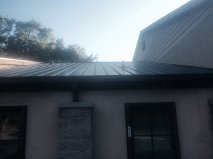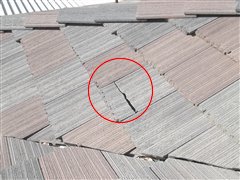Image of missing aggregate on some 3 tab shingles from an inspection a couple weeks ago.
Darrin Card
Card Inspection Services
Image of missing aggregate on some 3 tab shingles from an inspection a couple weeks ago.
Darrin Card
Card Inspection Services

This is a Boston Hip the roof was redone a year ago by a licensed roofing contractor, it is in great shape with no pop up nails and the boots/vents were done properly.
vince

Mastering Roof Inspections: Metal Roofs, Part 1
Beginner article which talks about metal roofs with purlin backers and how they are hard to recognize as metal. High-energy metals are generally the least resistant to corrosion and are called the least “noble” metals.
Mastering Roof Inspections: Metal Roofs, Part 2
This article is about corrosion, there are three types, galvanic, crevice and filiform.
Galvanic corrosion is an electrical process when dissimilar metals are connected by an electrolyte, such as water, the metal in the highest energy state; the less noble metal will corrode. Crevice corrosion takes place when a small volume of stagnant moisture is held next to a surface long enough for the moisture to penetrate the protective coating. Filiform corrosion appears as a thin filament, usually beneath paint, but sometimes beneath metal coatings. these are definitions of the three types of corrosion, it is good to know so it can be recognized.
Vincent McCrave
Very informative course and good review…

The above is a picture of a typical metal roof in SC.
I also read the two articles Hail Damage Pt 1 & 2. Some interesting facts about hail damage and even better pictures. The guy’s head is CRAZY! Ouch!
Roof inspection checklist.
ROOF
INSPECT:
__X__I inspected the roof‐covering materials:
__X__from the ground level
_____from the eaves
_____from a ladder
_____from the roof surface
_____from a window
__X__using binoculars
_____using a camera extension pole
_____The roof-covering materials were not inspected, because they were:
_____inaccessible
_____unsafe
_____not present
_____not within the scope of the inspection
_X___I inspected the gutters:
__X__from the ground level
_____from the eaves
_ ___from a ladder
_____from the roof surface
_____The gutters were not inspected, because they were:
_____inaccessible
_____unsafe
_____not present
_____not within the scope of the inspection
__X__I inspected from ground level or the eaves the downspouts.
_____The downspouts were not inspected, because they were:
_____inaccessible
_____unsafe
_____not present
_____not within the scope of the inspection
__X__I inspected the vents, flashing, skylights, chimney, and other roof penetrations:
_____from the ground level
_____from the eaves
_____from a ladder
_____from the roof surface
_____from a window
__X__using binoculars
_____using a camera extension pole
_____The vents, flashing, skylights, chimney, and other roof penetrations were not inspected, because they were:
_____inaccessible
_____unsafe
_____not present
_____not within the scope of the inspection
__X__I inspected from ground level or the eaves the general structure of the roof:
_____from readily accessible areas
_____from readily accessible panels
_____from readily accessible doors
_____from readily accessible stairs
_____The general structure of the roof from the readily accessible panels, doors or stairs was not inspected, because it was:
_____inaccessible
_____unsafe
_____not present
_____not within the scope of the inspection
DESCRIBE:
The type of roof‐covering materials I observed can be described as:
_X____asphalt shingle
_____wood shingle or shake
_____concrete or clay tile
_____metal
_____slate
_____other
REPORT:
_____I saw evidence of an active roof leak. Correction is needed.
__X___I saw evidence of a material defect. Correction is needed.
_____I saw evidence of a functional defect. Correction is needed.
__X___I saw evidence of a cosmetic defect.
There were large amounts of asphalt granules in the splash blocks and in the area around the splash blocks on the ground, recommend that roof be inspected by professional roofer.
Asphalt shingles on the eaves over the garage have started to move out of place due to failure of cement used to attach shingles. Recommend this be corrected. Shingles appear to be blistering and require further evaluation by roofing contractor.
Attached is a picture of a vent inside the attic that is in good condition.
Here are some pictures of a California shake roof where the elements and organic material have destroyed the roof. Surprisingly enough there was only an area on the inside the size of a fist where the leak showed up. The client could and wouldn’t believe that the roof covering was shot. All I can say is thank goodness for her that we’re in a drought. Notice the organic material and the holes all the way through the shakes and underlayment.
I am posting a picture in accordance with the guidelines of this course. This is a photo showing a leak penetrating through the sub-roofing and causing damage to a truss. This had a high moisture content suggesting an active leak. It was recommended that a structural engineer be contacted.

I inspected the roof on my current home for the requirement in this course. I walked the roof for the inspection. It is a hip roof with fiberglass shingles. It is five years old and in good condition with no visible issues. It doesn’t have a chimney and the vents are in great shape. Inspection of the attic space showed no issues with the trusses and that they were attached with clips and one metal strap over the truss.
Posting to complete this course. Here I inspected a roof with concrete tiles. As you can see several have come loose and cracked.



This photo shows unreliable flashing around a chimney. The Chimney was lined with a weather cap ,but, the clearance was too low.
Started this course, yesterday evening, 07.16.2015, and am presently about to download a few pictures, then do a report on same …
All observations were done by means of a ladder resting against the roof and by using binoculars. I did not ‘walk’ the roof.
Hip Roof, with a Ridge Vent running almost the entire length of the ridge, save for approx. 6" at either end.
There are two (2) direction changes which have Gable ends.
The Asphalt shingles are in the 19th year of the 25 year life span. Both of the ‘valleys’ created by the roof direction changes are ‘closed’. Could not determine if the underlayment is doubled or not.
In each of the valleys, a few pine needles were observed.
The condition of the shingles appears to be good, with none missing, all lying flat, and no rippling of the underlayment.
The eaves overhang extends 13" and 11" of that are soffits which have perforated screened panels covering the openings. The soffits run the entire perimeter of the house, up to the gable ends.
The gutters are of Aluminum construction, and are of two (2) sizes - 5" and 6",
and are attached to the fascia boards with K-Style Quick Screw Aluminum Gutter Hangers.
Atop all the gutters are leaf/pine needle guards.
I lifted up one section of the gutter guards near the middle of each gutter, to look directly at each gutter. Very few ‘needles’ were in each, and very little
‘grains’ from the asphalt shingle were observed either inside the gutters or atop of the guards.
The downspouts are at the rear corners of the house, and are of one piece Aluminum construction, which are attached directly to the sides of the house.
Two of the downspouts terminate at an underground drainpipe which has a ‘cleanout’ 6" from where the drainpipe enters the ground.
At the opposite corner of the roof, in the rear, are two (2) more down-
spouts, made of the same material, one-piece construction and extending to just short of the ground, where each has another pipe connected and fastened by screws and extending 6’ away from the house.
The roof has two (2) plumbing vent stack penetrations, and two (2) TV Dishes.
They are fastened to the roof by lag screws which penetrate through rubber bushings, one at each corner of the footing. Around the perimeters of each Dish footing, there appears to be roofing cement, with no gaps observed.
The flashing around each vent stack appears to be in good condition and there is not any apparent roof ‘staining’.
No recommendations are warranted.


Additional reading …
Re: Mastering Roof Inspections: Moisture Problems
Undoubtedly, everything I’ll learn from taking all these courses will help in advancing my career as a Home Inspector, but also too, these articles will guide me to solve problems ‘correctly’ in managing my own home … ‘moisture’ being a major one.
A lot of what I’ve read in this article, I have already experienced, and solved, but there are
some others that I have yet to encounter, or solve … funds being a big issue. 
Joe Schmoe’s Roof Inspection Report is listed in detail two (2) threads up from here …
Me


During a roof inspection, I came across some shingles at the eaves that were damaged. Unknown if the damage was mechanical or caused by ice as this is a house in Toronto, Canada where there are cold and snowy winters. The shingle in this photo is torn and partially blocking water flow in the gutter and that can lead to water damage to other areas of the roof and potentially entering through the fascia into the attic space. An immediate repair by a qualified roofer was recommended on the inspection report.